How well equipped was an English man-at-arms during the wars of the roses? I know it depends on social status so let's make 3 categories:
1. Knights
2. Esquires
3. Gentlemen
I've seen effigies of esquires in full plate armour which surprised me. I thought they had lesser equipment than knights, even most of the knights are better equipped than I thought!
I'm mostly interested in armour, but any info on weapons, horses, estates etc. is appreciated as well.
Questions on a similar topic: Is there any information on what sort of armour they wore? Was it mostly italian or german import, or was english armour preferred? I know Tobias Capwell suggests English armour is a different style, but do you think every Englishman used this style, or did some of them buy Italian imported armour?
The WOR was pretty much the heyday of full armour, with all military men having more and better armor than at any other point in history. Any soldier without head to toe protection would not last more than a few minutes in a Towton-type battle. I would expect that one would see both native-style (with enlarged gard-bras) and import armor from both Italy and Germany. WOR and the Burgundian wars are my favorite period, so I am interested in what some of the more knowledgeable people on this forum will have to say.
http://www.myArmoury.com/talk/viewtopic.php?p=250872#250872
in this thead i uploaded a drawing of an english harness from the WOR period or thereabouts,
its from christopher gravetts book series on the english knight. :knight, the noble warior of england 1200-1600 (read the link for more info on the book.
he also notes that italian imports were vastly preferred over German style Armour.
in this thead i uploaded a drawing of an english harness from the WOR period or thereabouts,
its from christopher gravetts book series on the english knight. :knight, the noble warior of england 1200-1600 (read the link for more info on the book.
he also notes that italian imports were vastly preferred over German style Armour.
Hi there
Tobias has proved English armour to be a different style. It appears that it was probably made in England as well, as opposed to imported in an English style. Most imports to England were from Italy, and they would have varied in style from the basic Munitions Italian export to Italian armours with English characteristics.
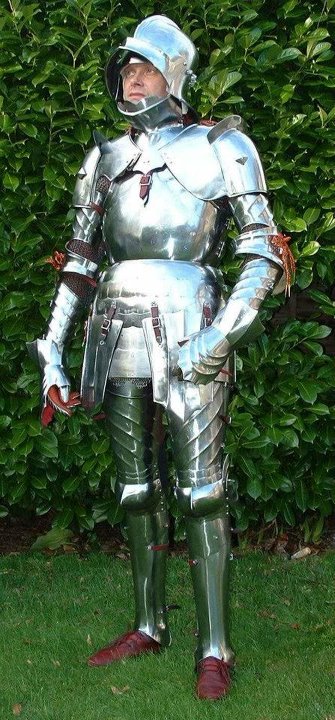
Graham Turner's English armour, made by William West, is an example of high end English armours from 1485. Richer knights would wear armour such as this, with lords and kings likely having parts of their harnesses gilded and silvered.
The cheapest head to foot armour was imported, whereas the most expensive was the English style. This is borne out in the effigies of the time, which tend to depict the higher members of society in the typical English style, with cheaper effigies seeming to be in imported armours. This is apparently reflected in the records, with the low end English armours costing a similar amount to the high end Italian.
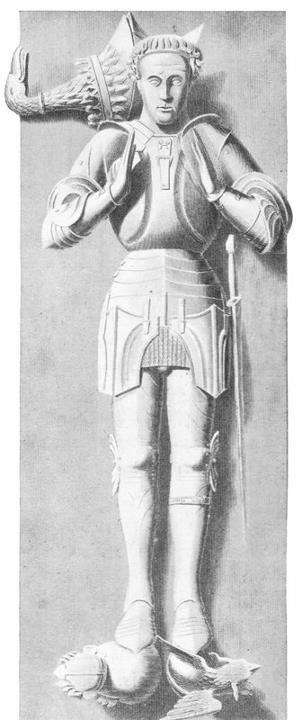
The armour depicted on the earl of Warwick's effigy is a good example. Although he himself would never have worn this armour, it demonstrates how the top players in England, even if they liked Italian armour, would add English characteristics to it. I am unsure if this exact armour ever existed. If it was then it was likely owned by the son of Richard Beachamp, one of the richest men in England.
As for what level of armour one would wear, I'm beginning to think more and more that it really depends on the actual battle and who the high level lords were taking part. Most imported armours were apparently bought up by the big houses, far more than would be worn by their family alone. These would be loaned to those who fought for the Lord, and collected in after the battles were done. Because of this trend I would expect that a battle between some minor nobles may have about 20% of the combatants armoured head to foot, while Battles involving people such as Warwick or the Stanleys would have a much higher percentage of people in full plate.
[ Linked Image ]
This manuscript image of the battle of Barnett shows many men in full plate. It is likely that many of these were not knights, and may not have owned their own armour. Barnett included some of the richest nobles of the time, and so large armouries would have been opened to equip the men fighting in the battle.
As for your examples, every one of those three categories would have access to full plate in the period. After the black death, the feudal system was mucked up something terrible, and title and financial power were not as linked as they used to be. Squires could be richer than knights, and gentlemen (by which I assume you mean men of wealth but no title) could be richer than both. None of these categories would go to battle with less than full plate. What would differentiate the wealth of the wearer would be both the style and finish of the full plate armour.
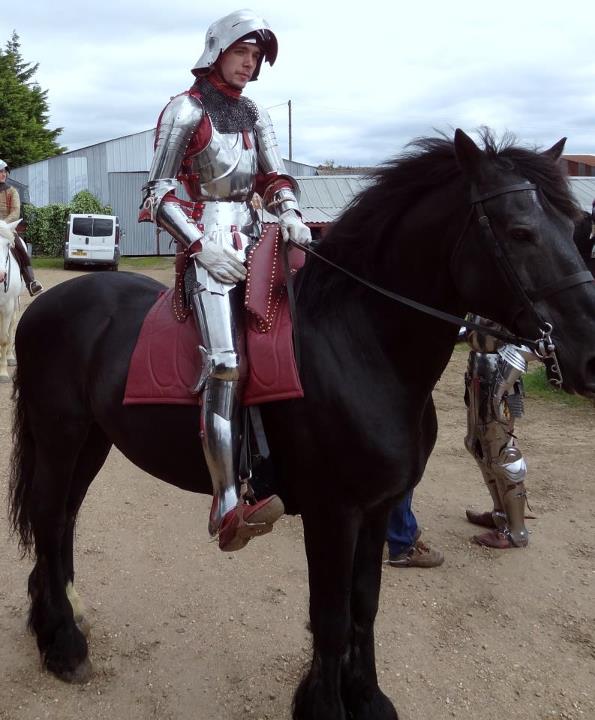
Although it is unlikely many German armours were worn in England (compared to the other styles), I can't resist showing mine off. This armour is based on several paintings of St George and St Michael, and as such would be a very high end armour. Most of this expense would be in getting the highly polished and planished finish. The same armour, black from the forge could be a full 70% less.
Hope this helps.
Zac
Tobias has proved English armour to be a different style. It appears that it was probably made in England as well, as opposed to imported in an English style. Most imports to England were from Italy, and they would have varied in style from the basic Munitions Italian export to Italian armours with English characteristics.

Graham Turner's English armour, made by William West, is an example of high end English armours from 1485. Richer knights would wear armour such as this, with lords and kings likely having parts of their harnesses gilded and silvered.
The cheapest head to foot armour was imported, whereas the most expensive was the English style. This is borne out in the effigies of the time, which tend to depict the higher members of society in the typical English style, with cheaper effigies seeming to be in imported armours. This is apparently reflected in the records, with the low end English armours costing a similar amount to the high end Italian.

The armour depicted on the earl of Warwick's effigy is a good example. Although he himself would never have worn this armour, it demonstrates how the top players in England, even if they liked Italian armour, would add English characteristics to it. I am unsure if this exact armour ever existed. If it was then it was likely owned by the son of Richard Beachamp, one of the richest men in England.
As for what level of armour one would wear, I'm beginning to think more and more that it really depends on the actual battle and who the high level lords were taking part. Most imported armours were apparently bought up by the big houses, far more than would be worn by their family alone. These would be loaned to those who fought for the Lord, and collected in after the battles were done. Because of this trend I would expect that a battle between some minor nobles may have about 20% of the combatants armoured head to foot, while Battles involving people such as Warwick or the Stanleys would have a much higher percentage of people in full plate.
[ Linked Image ]
This manuscript image of the battle of Barnett shows many men in full plate. It is likely that many of these were not knights, and may not have owned their own armour. Barnett included some of the richest nobles of the time, and so large armouries would have been opened to equip the men fighting in the battle.
As for your examples, every one of those three categories would have access to full plate in the period. After the black death, the feudal system was mucked up something terrible, and title and financial power were not as linked as they used to be. Squires could be richer than knights, and gentlemen (by which I assume you mean men of wealth but no title) could be richer than both. None of these categories would go to battle with less than full plate. What would differentiate the wealth of the wearer would be both the style and finish of the full plate armour.

Although it is unlikely many German armours were worn in England (compared to the other styles), I can't resist showing mine off. This armour is based on several paintings of St George and St Michael, and as such would be a very high end armour. Most of this expense would be in getting the highly polished and planished finish. The same armour, black from the forge could be a full 70% less.
Hope this helps.
Zac
Here are a couple of Graham Turner drawings of armor that he dates, one to 1460, and the other to Towton, 1461
 Attachment: 39.17 KB
Attachment: 39.17 KB
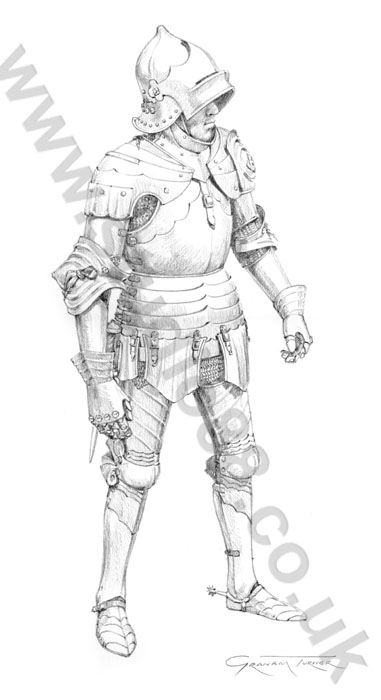
1460 - Graham Turner
 Attachment: 59.98 KB
Attachment: 59.98 KB
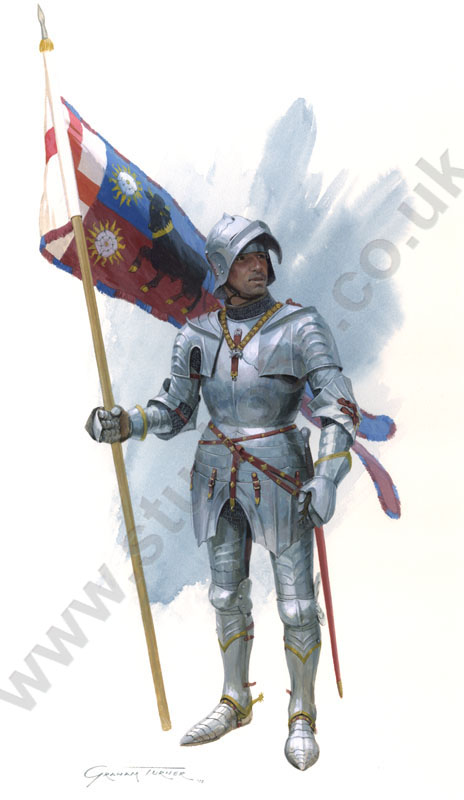
Towton - Graham Turner

1460 - Graham Turner

Towton - Graham Turner
| Zac Evans wrote: |
| Hi there
Tobias has proved English armour to be a different style. It appears that it was probably made in England as well, as opposed to imported in an English style. Most imports to England were from Italy, and they would have varied in style from the basic Munitions Italian export to Italian armours with English characteristics. 
Graham Turner's English armour, made by William West, is an example of high end English armours from 1485. Richer knights would wear armour such as this, with lords and kings likely having parts of their harnesses gilded and silvered. The cheapest head to foot armour was imported, whereas the most expensive was the English style. This is borne out in the effigies of the time, which tend to depict the higher members of society in the typical English style, with cheaper effigies seeming to be in imported armours. This is apparently reflected in the records, with the low end English armours costing a similar amount to the high end Italian. 
The armour depicted on the earl of Warwick's effigy is a good example. Although he himself would never have worn this armour, it demonstrates how the top players in England, even if they liked Italian armour, would add English characteristics to it. I am unsure if this exact armour ever existed. If it was then it was likely owned by the son of Richard Beachamp, one of the richest men in England. As for what level of armour one would wear, I'm beginning to think more and more that it really depends on the actual battle and who the high level lords were taking part. Most imported armours were apparently bought up by the big houses, far more than would be worn by their family alone. These would be loaned to those who fought for the Lord, and collected in after the battles were done. Because of this trend I would expect that a battle between some minor nobles may have about 20% of the combatants armoured head to foot, while Battles involving people such as Warwick or the Stanleys would have a much higher percentage of people in full plate. [ Linked Image ] This manuscript image of the battle of Barnett shows many men in full plate. It is likely that many of these were not knights, and may not have owned their own armour. Barnett included some of the richest nobles of the time, and so large armouries would have been opened to equip the men fighting in the battle. As for your examples, every one of those three categories would have access to full plate in the period. After the black death, the feudal system was mucked up something terrible, and title and financial power were not as linked as they used to be. Squires could be richer than knights, and gentlemen (by which I assume you mean men of wealth but no title) could be richer than both. None of these categories would go to battle with less than full plate. What would differentiate the wealth of the wearer would be both the style and finish of the full plate armour. 
Although it is unlikely many German armours were worn in England (compared to the other styles), I can't resist showing mine off. This armour is based on several paintings of St George and St Michael, and as such would be a very high end armour. Most of this expense would be in getting the highly polished and planished finish. The same armour, black from the forge could be a full 70% less. Hope this helps. Zac |
ah so that first harness is the one christopher gravett used as an inspiration in the book. awsome ive come to reall like the english style because it has the fancy fluting of gothic and uses sallets more often han not, bu also has that nice looking globose breastplate..
also, at some point being a knight became more restricted, so not every squire became one.
| William P wrote: |
|
ah so that first harness is the one christopher gravett used as an inspiration in the book. awsome ive come to reall like the english style because it has the fancy fluting of gothic and uses sallets more often han not, bu also has that nice looking globose breastplate.. |
Christopher Gravett wrote the book, while Graham Turner Illustrated it. Graham is a painter who took up jousting to find out more about what he was painting. Since then he has trained his own horse, and won the queens horn jousting trophy from the royal armouries: The only person ever to do so on their own horse. Graham's armour, which he wears in my photo, and painted in Christopher's book is based on the effigy of Sir Ralph Fitzherbert's. This particular style, with all the fluting, is from right at the end of the period, and the development of the english style is an interesting topic in it's own right.
Graham's website
Ryan,
I am not sure restrictive is the right word. Expensive maybe. Difficult, perhaps.
We see many European Monarchs trying to force knighthood on the wealthy to maintain the number of knights they had had earlier. This is for several reasons.
One they are a small group to start with. The issue is that in an era with one in five children dying before adulthood and the knightly/noble class being some small to begin with they need new blood all the time. In the earlier Medieval period this was no so much an issue as knights had not completely become a social structure. Once it does the increasing cost of a full 'knightly harness" and equipment coupled with a limited knightly class means less knights.
That said many gentlemen that were of knightly families simply forego knighthood though largely play the part in a military sense.
RPM
I am not sure restrictive is the right word. Expensive maybe. Difficult, perhaps.
We see many European Monarchs trying to force knighthood on the wealthy to maintain the number of knights they had had earlier. This is for several reasons.
One they are a small group to start with. The issue is that in an era with one in five children dying before adulthood and the knightly/noble class being some small to begin with they need new blood all the time. In the earlier Medieval period this was no so much an issue as knights had not completely become a social structure. Once it does the increasing cost of a full 'knightly harness" and equipment coupled with a limited knightly class means less knights.
That said many gentlemen that were of knightly families simply forego knighthood though largely play the part in a military sense.
RPM
| Zac Evans wrote: | ||
Christopher Gravett wrote the book, while Graham Turner Illustrated it. Graham is a painter who took up jousting to find out more about what he was painting. Since then he has trained his own horse, and won the queens horn jousting trophy from the royal armouries: The only person ever to do so on their own horse. Graham's armour, which he wears in my photo, and painted in Christopher's book is based on the effigy of Sir Ralph Fitzherbert's. This particular style, with all the fluting, is from right at the end of the period, and the development of the english style is an interesting topic in it's own right. Graham's website |
oh yes and now that i look back at the book, it says 'the knight carrying the poleaxe is based on the fitzherbert effigy c1475.. as part of the text to explain the hings being shown.
dont ask me how but i read that as meaning the poleaxe but not the armour was based off the fitzherbert effigy >.< despite the fact i have looked at that page literally dozens of times. that is really emmbarrassing, actually...
but is a really good looking armour , and 1475 is right at the zenith of pre renaissance armour alongside the gothic style.
Page 1 of 1
You cannot post new topics in this forumYou cannot reply to topics in this forum
You cannot edit your posts in this forum
You cannot delete your posts in this forum
You cannot vote in polls in this forum
You cannot attach files in this forum
You can download files in this forum
All contents © Copyright 2003-2006 myArmoury.com — All rights reserved
Discussion forums powered by phpBB © The phpBB Group
Switch to the Full-featured Version of the forum
Discussion forums powered by phpBB © The phpBB Group
Switch to the Full-featured Version of the forum